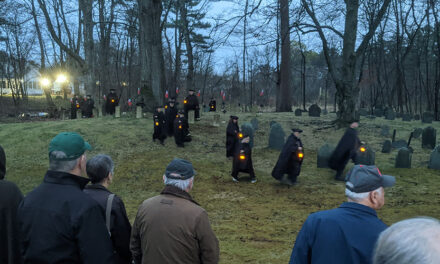Published in the September 21, 2016 edition
By MAUREEN DOHERTY
LYNNFIELD — A resident of Main Street concerned about the speed of motorists through the town center and its impact on safety took his concerns to the Board of Selectmen last week.
Thomas Iannuzzi’s house at 600 Main St. abuts the driveway that leads to the rear parking lot for the center shops. He recounted the numerous near-miss accidents he has witnessed between motorists who are stopped and waiting to take a left turn into the parking lot who nearly get rear-ended by those going straight.
He has also nearly been rear-ended turning into his own driveway numerous times, he said. Other times, motorists confuse his driveway for the shopping center’s or they become confused over which lane to use to turn down South Common Street.
Just this summer alone, Iannuzzi said he has seen “eight fender benders” and two-dozen near-misses in front of his home. He said it has gotten to the point where he will not cross the street to get to the town common with his 3-month-old daughter. He has seen other pedestrians attempt to cross Main Street with their kids to get to the common waiting for five cars to pass before one slows down.
“I think Main Street has become a dragway,” he said, adding he believes there are many factors contributing to it such as the smooth roadway surface, the fact that there are no traffic controls between Wakefield and Middleton, with the exception of the four-way stop at the midway point at Main and Lowell streets, GPS’s that get people easily off the crowded highway, and general confusion.
“I see it all the time. I am taking a left into my driveway and I’ll have someone on my rear, honking, before I can take my left. They’re going too fast,” Iannuzzi said.
Noting that there is an existing stop sign for motorists heading onto Main Street from South Common Street, Iannuzzi said installing two stop signs on Main Street to stop traffic heading toward Middleton and toward Wakefield would help improve safety. He thinks it could work similar to the four-way stop at Main and Lowell.
Selectmen Chairman Phil Crawford asked exactly where he’d like to see stop signs installed on the road.
Iannuzzi suggested one in front of Centre Farm for those heading toward Middleton and the other prior to a crosswalk that was recently installed near his home for those heading toward Wakefield.
The noise of motorcyclists cruising down Main Street also concerns Iannuzzi, enough so that he purchased a decibel meter to measure the volume of the noise that can be heard inside his house, which he says often exceeds legal state limit of 82 decibels at speed of 45 mph or less. He said he has measured the level outside his house at 120 dB and inside his house at “way above 82.”
Police Chief Dave Breen cautioned that decibel meters for home use are not accurate, explaining that police officers who used them are trained in their use to ensure that they are calibrated properly and used in a consistent manner to prevent false readings, such as if the noise is bouncing off curbing or other solid objects.
Breen explained that the decibel meter Iannuzzi bought would have to certified before the data collected could be considered reliable. Only one officer in the Lynnfield Police Department, Sgt. Nick Secatore, is currently trained to use a decibel meter, Breen said. In the past he has held clinics for motorcyclists to have their bikes tested to ensure they are within legal limits and he’d be willing to hold another one at some point.
Iannuzzi said he believes many of the noisy motorcycles have been modified after being purchased to increase the noise level beyond the legal limits. As many as 200 cyclists drive past his house on a weekend day, he said. Breen was doubtful that most motorcycles were being altered after purchase, stating it is much more difficult to retrofit a motorcycle than one would think.
Iannuzzi invited the chief to use his driveway for traffic enforcement or decibel measurements.
Breen said his department had conducted measurements of the speeds of cars through the center of town recently, tallying about 15,000 cars over a four- to five-day period. This was done using their radar trailer in its completely dark mode with all of its lights off and no speed limit sign attached, he said.
Breen said the average speed was 29 mph, and this average did not include any speed detected at less than 20 mph or during the middle school drop off and pick up times, which causes stop-and-go traffic through the center, because those anomalies would “skew” the results.
“If you take the 85 percentile, which the state would do, the average speed would be 24 to 26 mph. The speed limit is 25 mph, so the speed limit is appropriate for that area,” he said.
Breen said since last year his department has focused a lot its attention in the Walnut Street area due to the need for enforcement related to MarketStreet traffic and enforcing the truck exclusion area, which has been effective. He’d like to transfer some of his officers’ selective enforcement efforts “through the Main Street area, not just through the center” to mix it up.
Breen said when the four-way stop was originally proposed for Main and Lowell streets, he was not a big fan of them, but this location has proven to be a “fantastic” spot for it, noting that it was installed to prevent the T-bone accidents that had been occurring there.
“I’m not sure if the downtown area meets that criteria,” Breen said, deferring the question to the town administrator.
Town Administrator Jim Boudreau said, “You can’t use stop signs to control speed.” He also cautioned against any suggestion for speed bumps or rumble strips due to the noise that they would generate which would have the abutters begging for them to be taken out after one night of listening to the repetitive thuds, not to mention the problems they cause snow plows.
Boudreau agreed with Breen’s plan for more traffic enforcement in the area. “If they think the police are going to be there, they slow down,” he said.
Boudreau did offer a cautionary tale when it comes to traffic and road issues, drawing a laugh from the audience as he explained, “The first complaint I get is: ‘My road needs to be paved, it’s a mess.’ The second complaint I get is: ‘The construction is making a mess, I can’t get down my street, when are they going to be done?’ The third complaint I get is: ‘They’re flying down the street, I want the police out here running radar.’ And the last complaint I get is: ‘I didn’t mean me, I meant the other people that are driving fast.'”
Crawford agreed that increasing enforcement appeared to be the best option at this point.
Breen said his officers have noted that it has been getting more difficult to find motorists whose behavior “requires some type of enforcement action.”
“People want to come through Lynnfield because it is such a nice town. There is not a lot traffic in Lynnfield. There are not a lot of traffic control devices, so people on motorcycles want to come here because traffic is not fun when you are riding a bike; it’s very dangerous,” Breen said.
Crawford suggested that Sgt. Secatore could arrange to host a clinic to invite motorcyclists to voluntarily measure the decibel levels of their bikes before the riding season ends. He also suggested that Iannuzzi show his meter to the chief to test it and satisfy his curiosity about it. Iannuzzi said other communities, like Boston, had found a legal way to enforce the noise levels of motorcyclists that would stand up in court.
“Once that starts happening, these guys are going to talk to each other and they’re going to know. On any given Saturday, you’ll hear 100 drive by,” Iannuzzi said.
Crawford said Iannuzzi would be surprised by how many of these motorcyclists actually live in town as opposed to those just passing through.
Breen said speed enforcement would be done during the week and they’d do a noise enforcement on an upcoming Saturday, which satisfied Iannuzzi. Selectman Chris Barrett said once they get some data the matter can be discussed at a future meeting.




